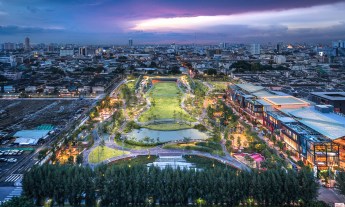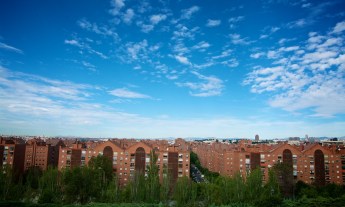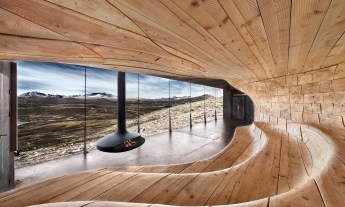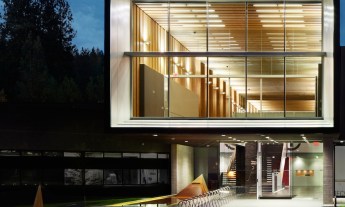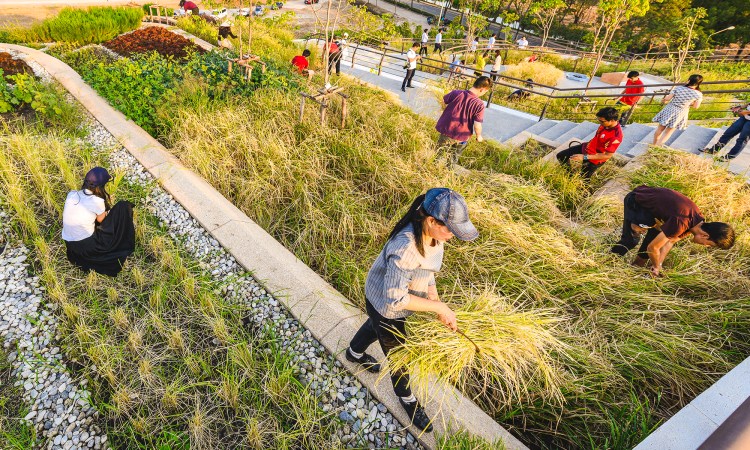
This green roof and farm offer a Swiss army knife of solutions — flood control, solar energy, fresh produce, green space for city dwellers, jobs, learning opportunities, and more — to some of our most pressing urban problems. Landscape architect Kotchakorn Voraakhom tells us how it works.
Could cities actually be designed to improve the environment? Bangkok, Thailand, landscape architect Kotchakorn Voraakhom, a TED Fellow, thinks so. Her imaginative work challenges the prevailing thinking that urbanization has to have a negative impact on the planet, whether it’s in the form of flooding due to paved surfaces, excessive energy use, disrupted biodiversity or the heat island effect.
With her firm Landprocess, Voraakhom has designed a new green roof on the Rangsit campus of Thammasat University, about 25 miles north of central Bangkok. Bangkok is extremely vulnerable to catastrophic flooding — in fact, according to the World Bank, nearly 40 percent of the city, which is built on a river delta, may flood annually by 2030, and this situation has been greatly exacerbated by paved-over earth and intensifying rainy seasons.
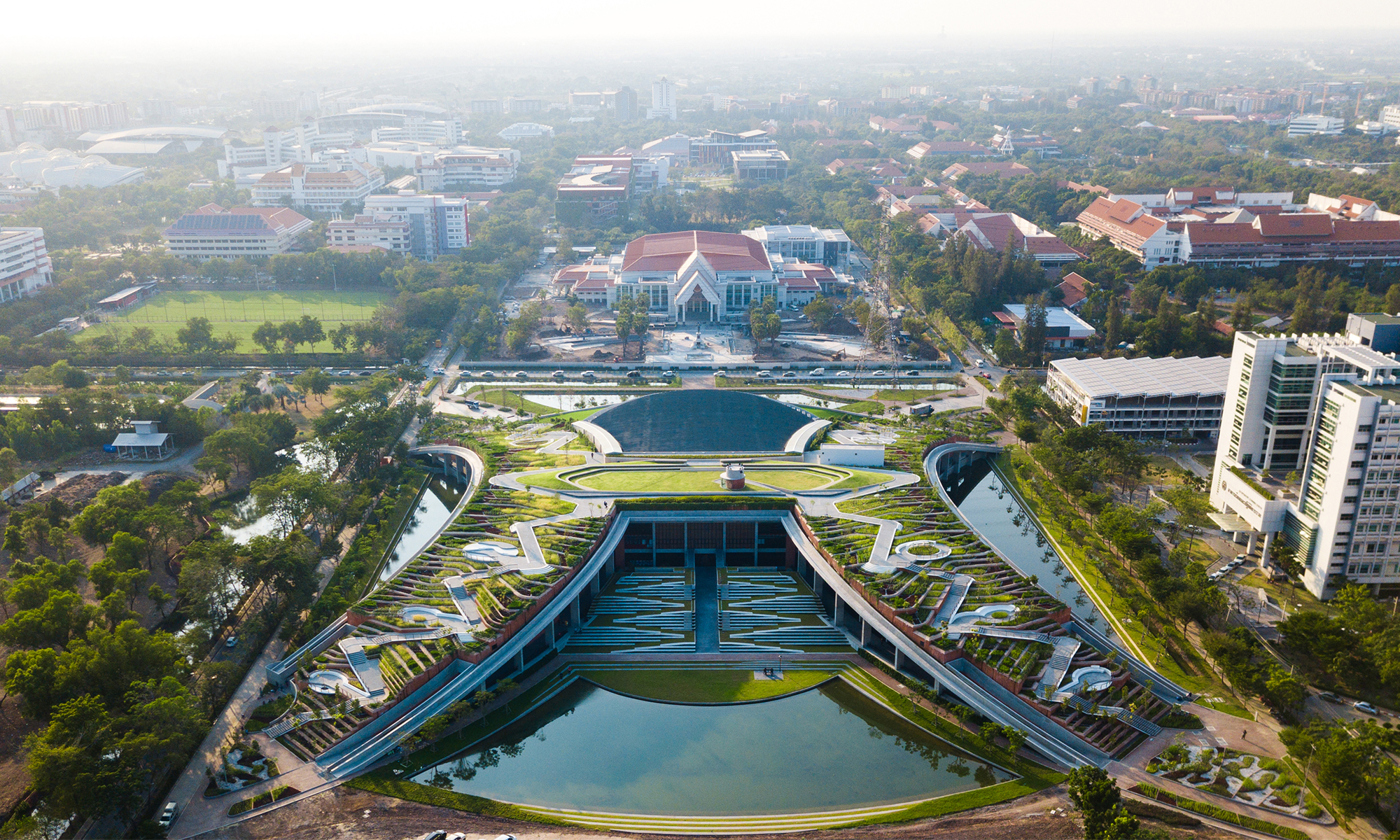
The Rangsit green roof is the follow-up to Voraakhom’s award-winning Chulalongkorn University Centennial Park, an 11-acre green space in downtown Bangkok that can capture and hold one million gallons of water in its retention pond and storage tanks and prevent it from submerging the city. (Watch her TED Talk: How to transform sinking cities into landscapes that fight floods.)
As if that weren’t impressive enough, Voraakhom’s new 236,806-square-foot structure — which opened in December 2019 — encompasses a flood-water management system and also Asia’s largest rooftop organic farm. “We’ve combined the principles of modern landscape architecture with traditional agricultural knowledge to create a Swiss army knife of environmental solutions, integrating water management, green energy, green public space, and more,” says Voraakhom. “Meanwhile, by 2050, 80 percent of the world’s population will live in cities, and water will be a scarce commodity. We need to start using city spaces more efficiently to ensure a secure and sustainable source of food production.”
The green roof, containing an H-shaped lush landscape, looks like a futuristic hill with a brick building nestled snugly beneath it. “The hill features an intricate pattern of zigzagging terraces of planted beds, leading all the way down to the bottom,” says Voraakhom. “When rainwater hits the roof, it cascades down the zigzags cut into its slopes while being absorbed by the soil in the beds.” The excess water is channeled into four retention ponds – with a capacity of up to 3 million gallons at the bottom of the mound. “The process slows down the flow speed of rainwater runoff by 20 percent compared to a normal concrete rooftop. This keeps a large amount of water out of the sewage systems, preventing the area from flooding during heavy rains,” she explains. The shape of the building also pays respect to one of the founders of the campus, economist Puey Ungphakorn. “‘Puey’ means ‘mound under the tree’ or ‘nourishment’ in Thai,” she adds.
Inspired by Thailand’s rice-growing tradition, the terraced structures were constructed using the ancient rammed-earth technique and are Voraakhom’s nod to the agricultural history of the rice terrace. “When I was thinking about this project, I tried to think about vertical architecture combined with a source of food, and it made me think of rice terraces and sloping hills in the northern part of Thailand and that kind of curved landscape architecture,” she explains. “A century ago, this area was outside of the main part of Bangkok city, filled with forests and swamps. A hundred years ago, King Rama V decided to devote this region to growing rice, so Thailand could become a major rice producer for the world. The king commissioned canals to control the water, and the region became known as Rangsit Fields, famed for its vast fields of rice.”
The city’s concrete urban sprawl took over throughout the 20th century, culminating in major redevelopment when Bangkok hosted the 1998 Asian games, according to Voraakhom. The fields were dug up to accommodate hundreds of thousands of people. Afterwards, the university moved a branch of its campus to the site, and dense commerce and industrial development sprang up around it. “Today, the university wants to demonstrate its commitment to environmental sustainability in its infrastructure as well as its curriculum, and I wanted to bring the agricultural landscape and tradition back to Rangsit Field as a source of food,” she says.
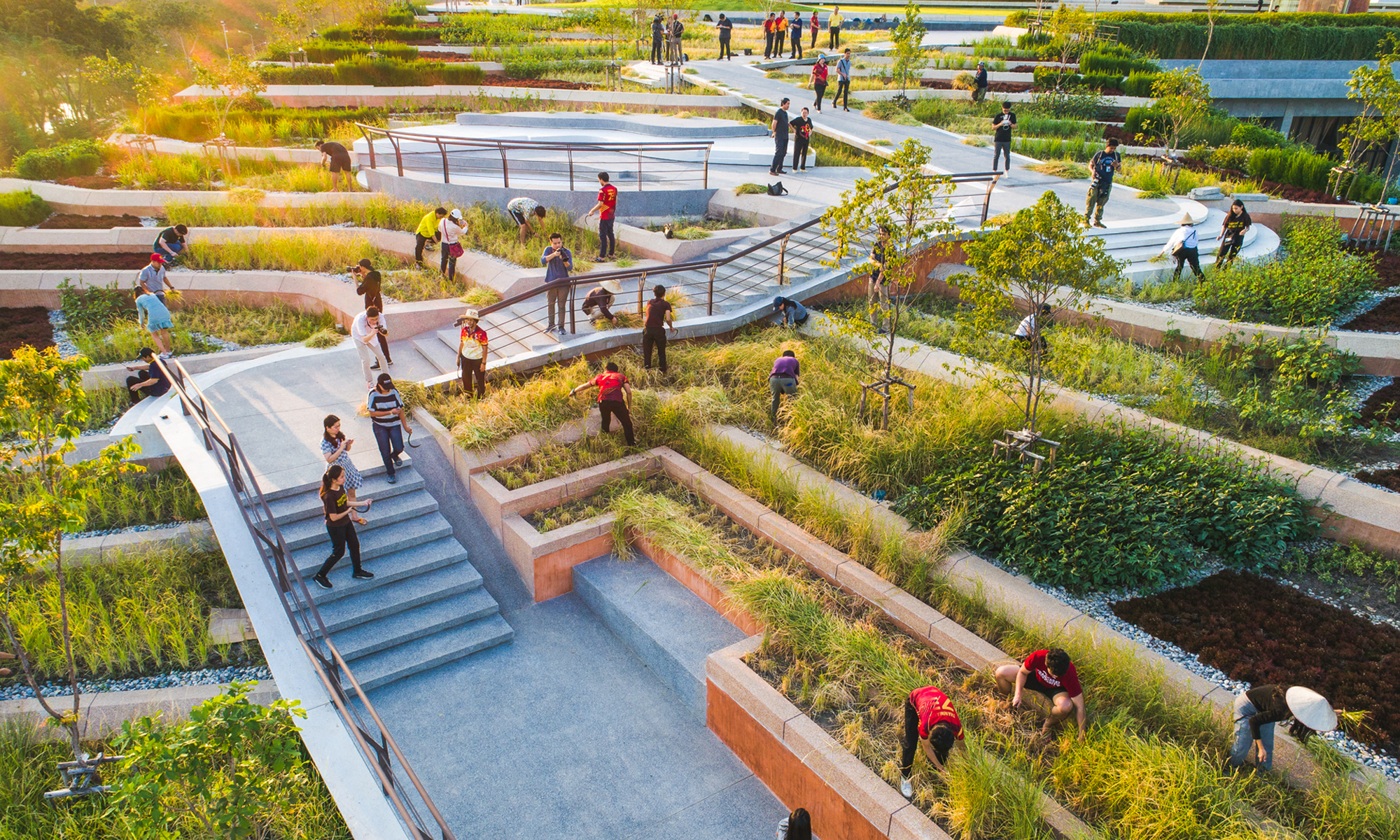
Voraakhom’s wish has come true: Rangsit Fields now boasts a 1.73-acre rooftop farm. The dome’s stepped terraces are filled with organically grown crops – including a drought tolerant variety of rice, and many indigenous vegetables and herbs, including red and green oak-leaf lettuce,Thai eggplant, green roselle, Thai red pepper, dill. “We’ve planted almost 50 species of vegetables, herbs and rice. We’ve already had a round of harvesting, and the farm will be able to supply the canteens on campus with 20 tons of rice, herbs and vegetables a year, providing approximately 80.000 meals,” says Voraakhom. “The food waste is composted to fertilize the farm, and water from the retaining ponds is used to water plants, creating an entirely localized, circular system.” Since all the plants are grown organically, there’s no synthetic pesticide pollution. “The farm also creates a habitat for pollinators, restoring biodiversity, and reduces the need for food transport, contributing to environmental health as well as healthy living,” she says.
The farm serves as an outdoor classroom and a source of local jobs, too. Staff hired by the university tend to the crops, and farmers offer workshops on sustainable agriculture, permaculture and nutrition as part of the university’s sustainability curriculum. “Students and community members are invited to participate in seasonal seeding, harvesting, and so on,” says Voraakhom. “Farming is a crucial part of our country’s heritage. The urban farm is training a new generation of organic farmers with real-world skills. It also fosters a sense of community.”
Not only does the building offer a patch of green in the city, it’s fueled by green power. Integrated into the roof design, solar panels installed at the top of the mound generates 500,000 watts of electricity per hour. This is used to power the building, including the water pumps that pull water up from the retaining ponds to irrigate the crops during the dry season. Thanks to built-in passive cooling, there is less need for energy-intensive air conditioning: The roof works to insulate the building from heat. Meanwhile, breezes blowing across the retaining ponds cool the air before it enters the building. “When the wind blows over the water in the ponds, it creates a microclimate that also cools the atmosphere around the building, helping to reverse the urban heat island effect, says Voraakhom.
This project, which cost roughly $31.6 million US to build and includes the 538,196-square-foot building underneath, offer a compelling demonstration of what’s possible as we rethink how we can live and thrive in our urban areas. Is it possible to build climate resilience — and even food production and community well-being — into all future cities? Voraakhom believes that many aspects can serve as a template for urban planners and architects who are striving to build sustainable cities. “The green roof and urban farm at Thammasat University show how climate resilience-focused development can perhaps begin to contribute more environmental benefits than problems,” she says. “And maybe even help resolve some of the problems of the past.”
All photos and images: Landprocess.
Watch her TED Talk here:










